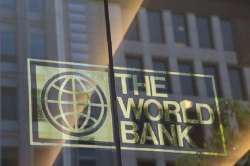Growth in India projected to accelerate to 7.3 per cent in 2018-19 fiscal: World Bank
Growth reached 6.7 per cent in fiscal year 2017/18, with a significant acceleration in recent months, it said.

Growth in India is slated to accelerate to 7.3 per cent in the 2018-19 fiscal and to 7.5 per cent in the next two years, the World Bank said on Sunday, adding the Indian economy appears to have recovered from the temporary disruptions, which resulted out of demonetisation and the introduction of the Goods and Services Tax (GST).
The global lender however, said the macro-economic outlook is being impacted by domestic risks and less benign external environment.
Growth reached 6.7 per cent in fiscal year 2017/18, with a significant acceleration in recent months, it said.
"Prompted by the adoption of the 'Goods and Services Tax' (GST) and the recapitalisation of banks, growth in India is firming up and it is projected to accelerate further," the World bank said in its latest report on South Asia.
It further said growth in the country is likely to rise to 7.3 per cent in fiscal year 2018/19 and to 7.5 per cent in the following two years, with stronger private spending and export growth being the key drivers.
The turnaround in the second half, on the production side, was led by manufacturing (that grew at 8.8 per cent versus 2.7 per cent in the first half).
According to the report, there was improvement in agricultural growth, while the services growth held steady at 7.7 per cent.
On the demand side, however, the pick-up in growth was reflected in a sharp acceleration in gross fixed capital formation to 11.7 per cent in the second half, from 3.4 per cent in the first.
The report also said consumption remained the major driver of growth, which gained 7 per cent in the second half.
The World Bank also observed the external situation has become less favourable and the current account balance has deteriorated.
A worsening trade deficit has led the current account deficit to widen -- on the back of a strong import demand, higher oil prices and exchange rate depreciation -- from a benign 0.7 per cent of the GDP in fiscal year 2016/17 to 1.9 per cent in fiscal year 2017/18, it said.
External headwinds - monetary policy 'normalisation' in the US coupled with recent stress in some Emerging Market and Developing Economies – have triggered portfolio outflows from April 2018 onwards, the report said.
It said that as a result, the nominal exchange rate depreciated by about 12 per cent from January to September 2018, and foreign reserves declined by over 5 per cent since March, while remaining comfortable at about nine months of imports.
The World Bank said that high oil prices and an uncertain global trade environment may pose challenges for the current account, given that India faces continued internal and external risks.
"A widening trade deficit is likely to lead to a current account deficit of around 2.6 per cent of the GDP in fiscal year 2018/19, and tighter global financing conditions will put added emphasis on India's ability to attract Foreign Direct Investment (FDI)," it said.
Fiscal consolidation is expected to resume in fiscal year 2018/19, but slippages could happen on both the revenue side (as the GST is still stabilising) and the expenditure side (ahead of state and federal elections), it added.